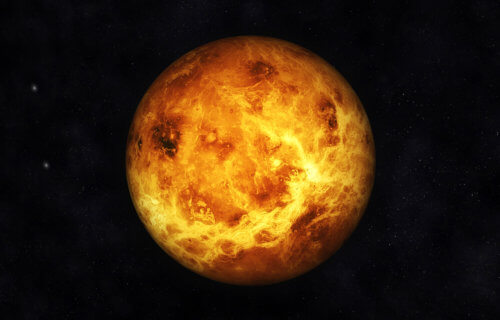CARDIFF, United Kingdom — When we think about the possibility of life on other planets, many people probably look at Mars. A stunning new report finds Earth’s other neighbor may actually be home to the clues astronomers are seeking. Researchers have discovered rare molecules on Venus which may be a sign of life in the planet’s clouds.
The international team of astronomers say phosphine, a rare mixture of hydrogen and phosphorus, is currently floating freely above the scorching hot surface of Venus. Professor Jane Greaves explains that phosphine can only be made industrially or by microorganisms which thrive in oxygen-free environments.
The team made this discover at the James Clerk Maxwell Telescope (JCMT) in Hawaii and were then granted the chance to continue the research using 45 high-powered space telescopes at the Atacama Large Millimeter/submillimeter Array (ALMA) in Chile. Both locations are capable of viewing Venus in much greater detail than the human eye can see, magnifying to a wavelength of about one millimeter.
“This was an experiment made out of pure curiosity, really – taking advantage of JCMT’s powerful technology, and thinking about future instruments,” Prof. Greaves says in a media release. “I thought we’d just be able to rule out extreme scenarios, like the clouds being stuffed full of organisms. When we got the first hints of phosphine in Venus’ spectrum, it was a shock!”
Where’s the phosphine on Venus coming from?
The team is now looking at how these molecules are being made on the second planet. Using models and calculations, researchers are quickly ruling out the possibility phosphine is just a naturally occurring item on Venus.
Dr. William Bains of MIT finds sunlight, minerals blown into the clouds from Venus’ surface, volcanoes, and lightning could all play a role in creating phosphine. These natural sources however produce only a small fraction of the amounts astronomers are seeing. The study finds these causes could only make one-ten-thousandth of the phosphine amounts currently swirling around Venus.
Professor Hideo Sagawa of Kyoto Sangyo University reveals there are about 20 molecules of phosphine for every one billion particles in the planet’s cloud layer. This is a relatively scarce amount, but researchers explain that organisms can easily produce this with little energy.
On Earth, bacteria can absorb phosphate minerals, add hydrogen, and expel phosphine as a gas. Why they do this isn’t clear but other scientists suspect it wards off rival bacteria.
A completely alien microbe?
Dr. Paul Rimmer of Cambridge University believes microbes on Venus will likely be very different from their cousins on Earth. If they are there and producing phosphine, the study finds these organisms have to contend with a much harsher environment than those here.
Study authors admit they’re a long way from proving life exists on Venus. Although the clouds there actually have a livable temperature of 86 degrees Fahrenheit, they’re about 90 percent sulfuric acid.
“Finding phosphine on Venus was an unexpected bonus! The discovery raises many questions, such as how any organisms could survive,” Dr. Clara Sousa Silva of MIT adds. “On Earth, some microbes can cope with up to about 5% of acid in their environment – but the clouds of Venus are almost entirely made of acid.”
Venus is a happening place
This isn’t even the first bit of exciting news to come from Venus this year. In July, another report from the University of Maryland found the planet still has dozens of active volcanoes under its surface.
Researchers say hotspots are still changing the planet’s surface, debunking theories that the planet is dead and inactive.
“A key question in science is whether life exists beyond Earth, and the discovery by Professor Jane Greaves and her team is a key step forward in that quest,” Professor Emma Bunce of the Royal Astronomical Society says.
Greaves’ team is now waiting for more time with these special telescopes to search for other gases associated with life. The next space mission planning to explore Venus will be Europe’s EnVision, set for 2032.
The study appears in the journal Nature Astronomy.

Long before are planet cooled down! Mars was earth, as the sun was almost twice the size it is today. Mars was filled with water, so life started there first! Now the ? Should be how advanced was it before they dried out, the surface is dead, we know nothing about what’s underneath the surface!